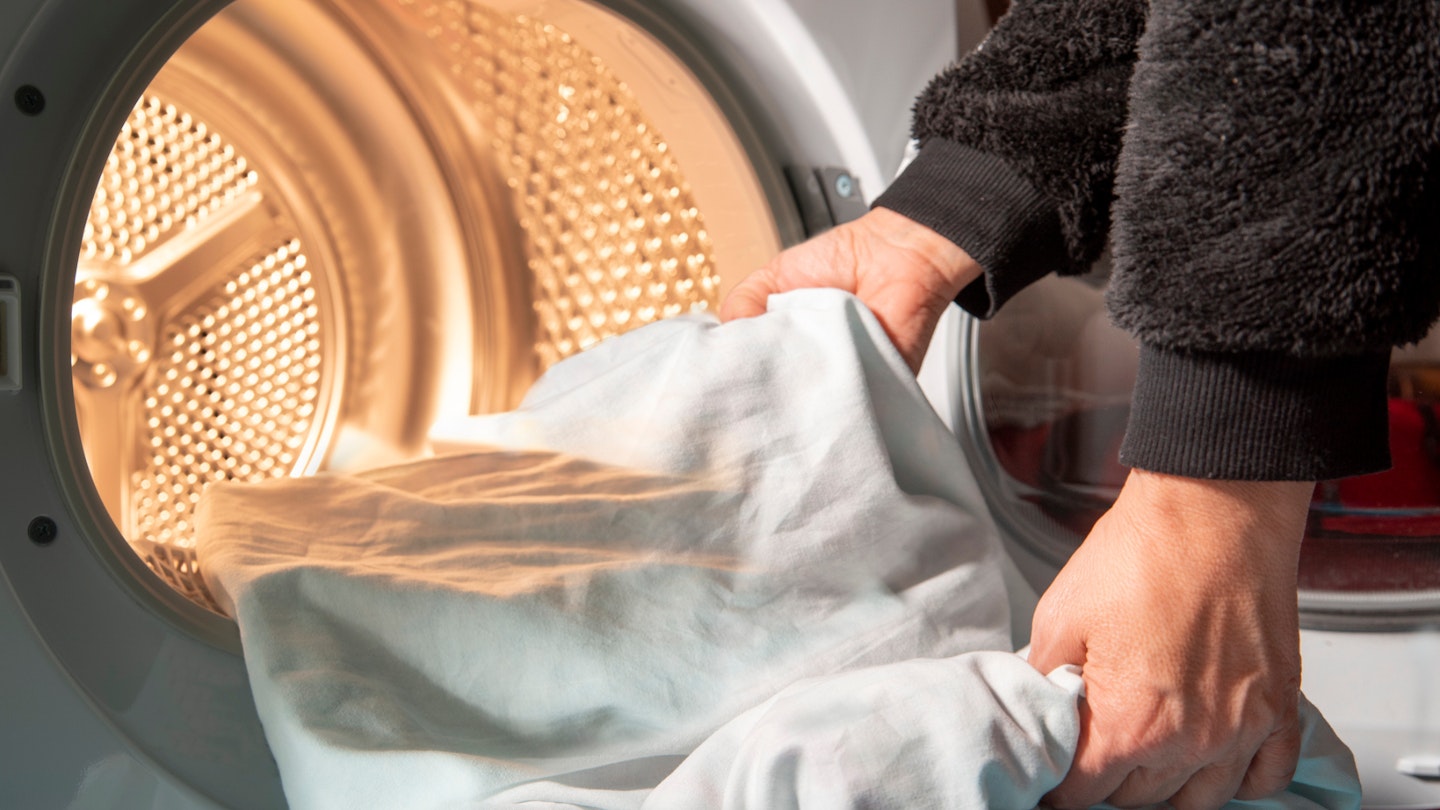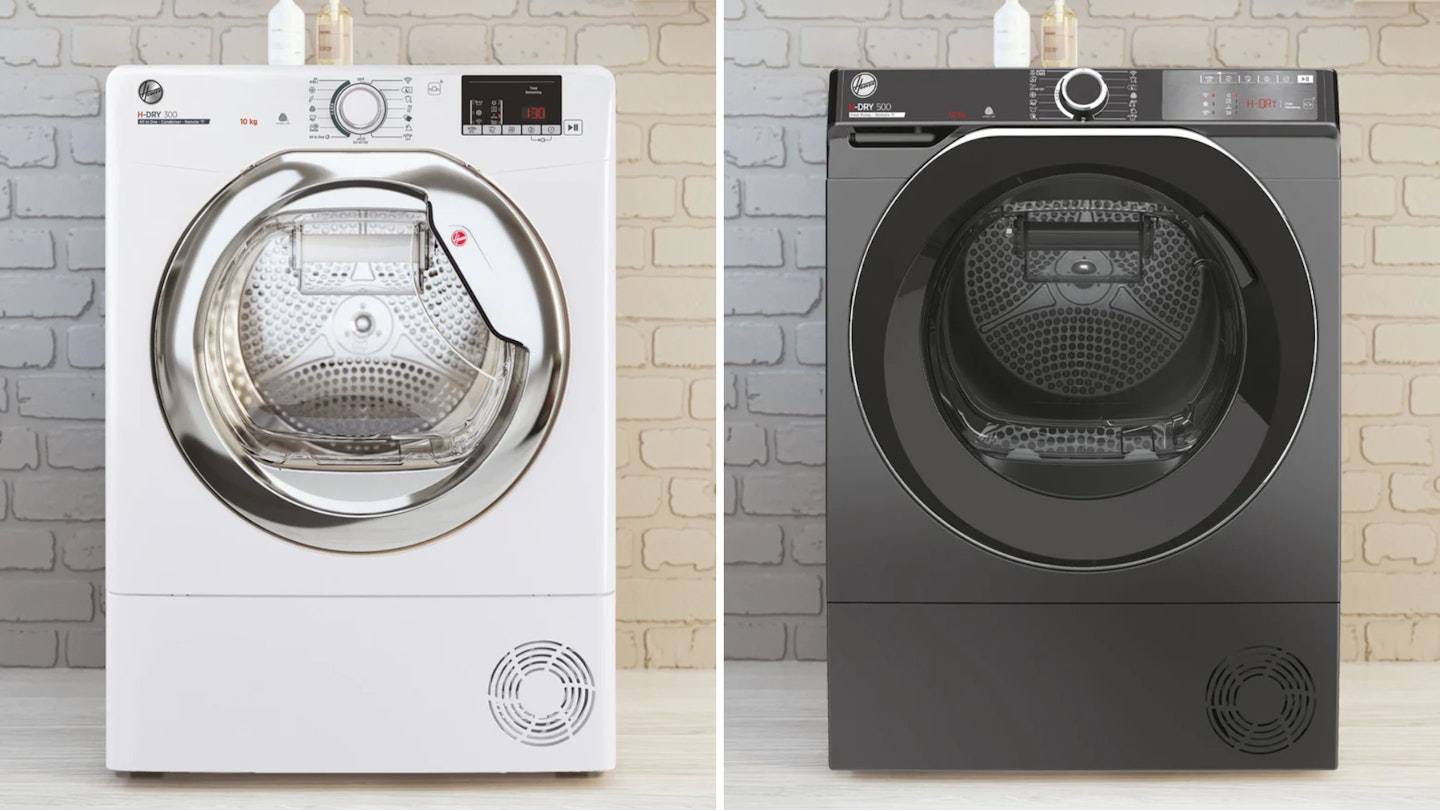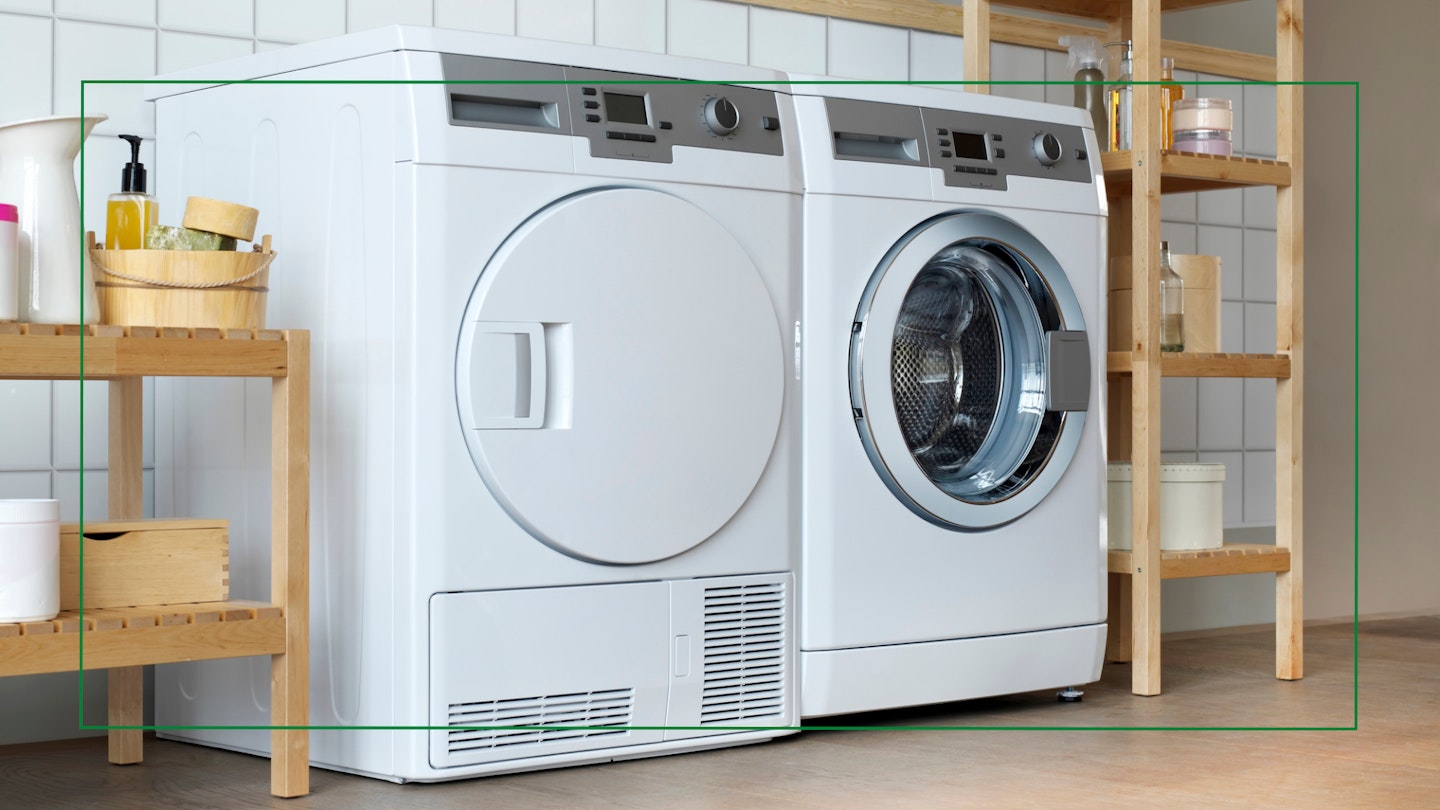If you're in the market for the best type of tumble dryer, what is 'best' will be determined by your needs. A tumble dryer isn't a necessity for all homes but depending on your household's size and demands, it could prove to be a godsend. Especially if clean washing can't come quick enough! To help you find out exactly what you need to know to find best tumble dryer for you, we spoke to the experts - Vivien Fodor, Laundry Category Manager at Hotpoint and Ryan Long, Laundry Category Marketing at Indesit. Coming from two huge brands in the washing machine and tumble dryer world, you can trust them to have all the answers.
Before we get started on the different types, it's worth considering your budget. Tumble dryers range in price from around £200 for lower capacity budget dryers to over £2,000 for seriously smart and high-spec options. Each tumble dryer is designed with distinctive features tailored to meet specific laundry needs, whether that be an anti-allergy cycle for removing dust mites or a child lock for families with young children. Depending on your household, there are going to be some features necessary to your home, while others may go redundant, so it's important to check the full details of your machine to ensure you're getting the best value for money.
Not only that but the planned placement and type of tumble dryer can also affect your budget - so let's break it down below.
Tumble Dryer Types

Vented Tumble Dryers
A low-cost solution, "vented tumble dryers use a heater to create warm air to dry your laundry." says Vivien. "Damp air will need to be funnelled away through an external vent hose, so you'll need to install this appliance near an external wall or a window."
Pros
Vented tumble dryers tend to be more affordable.
They can be easier to install than other types of tumble dryer.
Cons
Vented dryers require a venting system, so they needs to be installed near an external wall or window. This may limit places to locate the appliance.
They tend to be the least energy-efficient.
Condenser Tumble Dryers
"Condenser tumble dryers use a heater to create warm air to dry your laundry, and then collect the moisture in an easy-to-empty container," shares Vivien. "Condenser dryers differ from vented as they do not require a vent hose, so they're convenient to install."
Pros
Condenser tumble dryers are easy to maintain with a reservoir that can be easily emptied after each cycle.
They offer more flexibility in terms of placement since they don't require a vent.
Cons
Typically more expensive than vented tumble dryers.
They also use slightly more energy as they heat the air and then cool it to condense the moisture.

Heat Pump Tumble Dryers
"Heat pump tumble dryers are the most efficient way to tumble dry your laundry," says Vivien. "Unlike traditional vented or condenser models, heat pump dryers do not use a heating element to dry your laundry, instead they use recirculated air to gently dry and protect your clothes at a cooler temperature."
Pros
Heat pump tumble dryers are the best in class for energy efficiency, which makes them more cost-effective to run over. time!
They take greater care of your clothes in the drying cycle.
Cons
High upfront cost compared to other types.
The drying cycle may be longer as they operate at a lower temperature to protect fabrics and save energy.
Washer Dryer
As the name suggests, a washer-dryer is a washing machine and tumble dryer in one. It’s great if you’re limited on space and can only fit one appliance in but it’s worth noting that the tumble dryer won’t perform quite the same as the standalone version. There’s less capacity to dry clothes and they may take longer in comparison.
Pros
Washing machine and tumble dryer in one.
Space saving.
Cons
The dryer is not as high-performing compared to freestanding tumble dryers.
Tumble Dryer Fit Type

As well the dryer type, you also have options for the tumble dryer placement, so consider where in the home you want your tumble dryer to live:
Freestanding Tumble Dryer
Most dryer types come as freestanding options which means that they stand on their own without being hidden away, and provide you with more freedom. You will get access to tumble dryers in a greater variety of sizes and the choice to place them anywhere you like in the home. That being said, you'll still need to ensure they're placed in a well-ventilated space and a vented tumble dryer has a hose leading outside.
Integrated Tumble Dryer
An integrated tumble dryer is one that’s designed to easily hide away, whether that’s beneath your counter in a matching kitchen unit or behind a kitchen cupboard door. It’s perfect if you have other integrated appliances, prefer a more sleek aesthetic, and want to keep your tumble dryer out of sight, out of mind. However, as they are built to fit standard cabinet sizes, you will be more limited on tumble dryer sizes.
What To Look For When Purchasing A Tumble Dryer
But the decision-making process doesn't stop there. Alongside the type of tumble dryer, there are plenty of key features to consider that not only set machines apart from others but will also bring light to the unique needs of your household. It can depend on your household size, the amount of drying you'd need to get through in a week and more.
Key Features To Look For
Drum Capacity
The drum capacity dictates how much you can load into your tumble dryer at one time. Tumble dryers can vary in capacity from 3kg drums up to 10kg, with 7kg-10kg being the most common for freestanding. The larger the capacity, the more energy-efficient is also tends to be. If you’re not sure which to go for, here’s a general guideline:
3-6kg: Small drum – Best for single households.
7-8kg: Standard drum – Best for small to medium households.
9kg+: Large drum – Best for large families.

Size
The drum capacity can affect the size of your tumble dryer; you’ll likely find that the larger the drum capacity, the larger the machine. It's important to measure up your tumble dryer and the space you plan to place it before buying to ensure it fits.
A standard freestanding tumble dryer can measure H85 x W60 x D46-70cm depending on the drum. Integrated machines typically have H82-85 x W60 and a depth of between 55-60cm.
But it’s not just the size of the machine you need to consider. You’ll also need to add 3cm to the depth of a machine to allow space for a pipe connection and for a vented tumble dryer, you may need to leave extra space.
If you want to put a freestanding tumble dryer beneath your kitchen countertop in an alcove, this may be possible if measured correctly, it just won't have the door concealing it.
Energy Efficiency
Sadly tumble dryers aren't known for being the most energy efficient - when shopping the higher the energy efficiency rating of your tumble dryer, the less power it uses which makes it better for the planet and your wallet. In tumble dryers, the annual energy consumption (kWh/year) is based on 160 cycles on a cotton drying programme - approximately three cycles a week.
Unlike washing machines, tumble dryers use the old energy rating from A+++ to D. That being said, the energy class D-rated dryers have been banned since 2013, so you'll only find energy ratings of A+++ to C on the UK market. A+++ is the most economical.

You may also find that certain tumble dryer brands have extra sensor programmes to avoid wasted energy (more on that below). Others, like Indesit and Hotpoint among others, have partnered with Youreko to translate ratings into financial returns – making it easy to compare savings and running costs between appliances when shopping.
Noise
Tumble dryers can be noisy - and who wants to hear your machine buzzing in the middle of the night? It can be particularly annoying if you have a modern, open-plan home and have to turn up the TV to drown out the thrum of the drying cycle. Thankfully many brands have quieter motors included to help make the machine as quiet as possible.
The regular noise level for a tumble dryer is around 70 decibels (dB) - for reference, a normal conversation is around 50dB. The quieter the tumble dryer, the less it'll interfere with family life.
If you’re after the quietest washing machine available, look for those that have been awarded the Quiet Mark Award. This certification makes it easier for us as consumers to find the quietest options for our homes.
Programming
Tumble dryers have two programme types - manual and sensor. Manual tumble dryers use a programmable timer that rely on you to set the time with guide times available for different fabrics - often cotton, synthetics and delicates. They're typically cheaper than sensor tumble dryers and come with fewer options.
Sensor tumble dryers have more programmes to tailor to specific item needs and use in-built technology to detect when your laundry is dry. This means that the cycle ends once your clothes are dry without wasting energy or time. This type of machine is typically the most popular and you may find options for the following programmes among others:
Delay: This setting allows you to start the tumble dryer at a later time.
Easy Iron: This setting gently spins the drum once the cycle is complete to prevent creases, making ironing (or not ironing) a whole lot easier.
Quick Dry: This setting will dry your clothing pronto - though a smaller load is needed - in as little as 14 minutes.
Extra Dry: This setting results in a longer cycle time to help dry bigger, bulkier garments such as bedding and towels.
Cupboard Dry: Forget your clothes still being slightly damp - this setting, also known as 'ready to wear', makes sure your laundry is dry enough to immediately put away.
Reverse Tumble: If you want to prevent clothes from getting tangled in the machine, this setting changes the direction during the cycle to help stop your laundry from getting muddled together.
Wool: A setting specific to woollen garments, though first check the clothing is Woolmark-approved and the tumble dryer has been approved by The Woolmark Company.
Anti-Allergy: Perfect for any allergy-sufferers, this setting removes allergens including dust and mites.

Extra Features To Look For
Child Lock
If you're a family with young children, this might be a shout but it's not something all tumble dryers are equipped with. This feature can be activated to lock the door meaning it can't be opened mid-cycle by mischievous little ones.
Self-Cleaning
Regular maintenance is recommended to keep your tumble dryer in tip-top condition, but a tumble dryer with self-cleaning can help streamline the chore process. Some automatically clean the machine for you, blasting lint and dirt that builds up the drum.
Smart Connected
Smart tumble dryers put the power right in your hands. With a Wi-Fi connection, you can control your machine via an app on your phone. Different brands offer different types of smart features, but some include starting your cycle remotely, checking the cycle progress, and smart diagnostics reporting which will update you if something goes wrong. Some even give you the option to download extra settings to customise your laundry needs.
How To Clean A Tumble Dryer
"It’s important to keep your tumble dryer in tip-top shape with regular maintenance," says Vivien. "Cleaning the lint filter before each cycle, clearing out the exhaust vent to prevent blockages and even wiping down the drum every few months to remove lint buildup can keep your dryer in pristine condition. These steps will help maintain the performance while extending the lifespan and preventing laundry mishaps."
Hotpoint has a thorough step-by-step guide to cleaning each type of tumble dryer and you can watch the video below for their guide to keeping your tumble dryer smelling fresh and clean.
How To Install A Tumble Dryer?
Most retailers offer the option to install your tumble dryer and remove and recycle your old dryer if necessary. It is an added cost but we'd recommend it as it takes the faff out of the process and you won't need to worry about moving a bulky appliance on your own.
However, if you do want to install your tumble dryer yourself to save a bit of money, we’d recommend following the operating instructions provided in your appliance manual to fit it properly. This vent hose Indesesit may also prove helpful for getting a vented tumble dryer in place.
Where To Buy A Tumble Dryer?
To look for a quality tumble dryer, we’d recommend the following retailers. As well as having the best tumble dryers available, all of which are reputable for their quality customer service.
AO
John Lewis
Currys
Argos
Boots Kitchen Appliances
Appliances Direct
You can also buy directly from reputable tumble dryer manufacturers including Hoover, Miele, Beko, Bosch, Samsung, Hotpoint and Indesit.
Tumble Dryer FAQs
Which Type of Tumble Dryer Is Most Energy-Efficient?
"Although heat pump dryers can take longer to dry laundry than vented and condenser models," says Vivien, "they’re much more efficient to run and the lower temperatures mean they’re gentle on clothes. For a good example of an energy-efficient tumble dryer is the Hotpoint H8 D94WB UK Freestanding Heat Pump 9kg Tumble Dryer."
How Can You Save Energy And Money When Using A Tumble Dryer?
Ryan recommends several simple ways to save energy and money when using a tumble dryer, including:
Full loads: Dry full loads whenever possible, as running smaller loads wastes a lot of energy.
Dry similar fabrics: Group similar fabrics together as they tend to dry at similar rates. This ensures that some items don’t over-dry while others are still damp.
Clean the lint filter: Regularly clean the lint filter before each cycle. A clogged filter reduces airflow and makes the dryer less efficient.
Opt for a heat pump dryer: Heat pump technology ensures efficient resource consumption and in turn helps to reduce running costs whilst taking care of the environment.
Add dryer balls to your load: Vivien also recommends placing dryer balls into the drum to untangle your laundry, maximising warm airflow for a quicker and more efficient cycle, whilst looking after your purse strings. Not only that, but they help to prevent your laundry from creasing, meaning less ironing and cheaper energy bills.
Which Type Of Household Can Most Benefit From A Tumble Dryer?
"Tumble dryers can be beneficial for various types of households," says Ryan, "particularly those with busy schedules and limited outdoor drying space. When the weather’s not behaving, choose a tumble dryer to get your clothes dry, full of bounce and re-invigorated. Choose between heat pump, condenser and vented models, so there's something for every home."
Eleanor Weaver is the Deputy Homes & Garden Product Editor at Bauer, specialising in kitchen accessories and appliances, including washing machines and microwaves. Having been a renter for a decade now, she loves looking for home inspiration in her spare time and is a master of DIY.
